Leading and Managing Teams: Effective Leadership Strategies
VerifiedAdded on 2022/08/26
|5
|1149
|13
Essay
AI Summary
This essay examines the critical role of leadership and management in enhancing team effectiveness within multinational and global companies. It highlights the significance of team cohesion, cooperation, and commitment for successful task completion. The essay explores four key methods for leaders to effectively guide teams: building trust and goodwill through activities like icebreakers; implementing team-building exercises to foster interaction and address tensions; facilitating discussions by establishing ground rules and encouraging participation; and managing tasks through time management, delegation, and support. The essay emphasizes the importance of effective communication, emotional and cultural intelligence, and creating a positive team dynamic to improve team performance. It concludes that empathy, understanding, and democratic practices are crucial for team leaders to ensure positive team dynamics and optimize performance. The essay references studies on transformational leadership, team-building, and teamwork training to support its arguments.
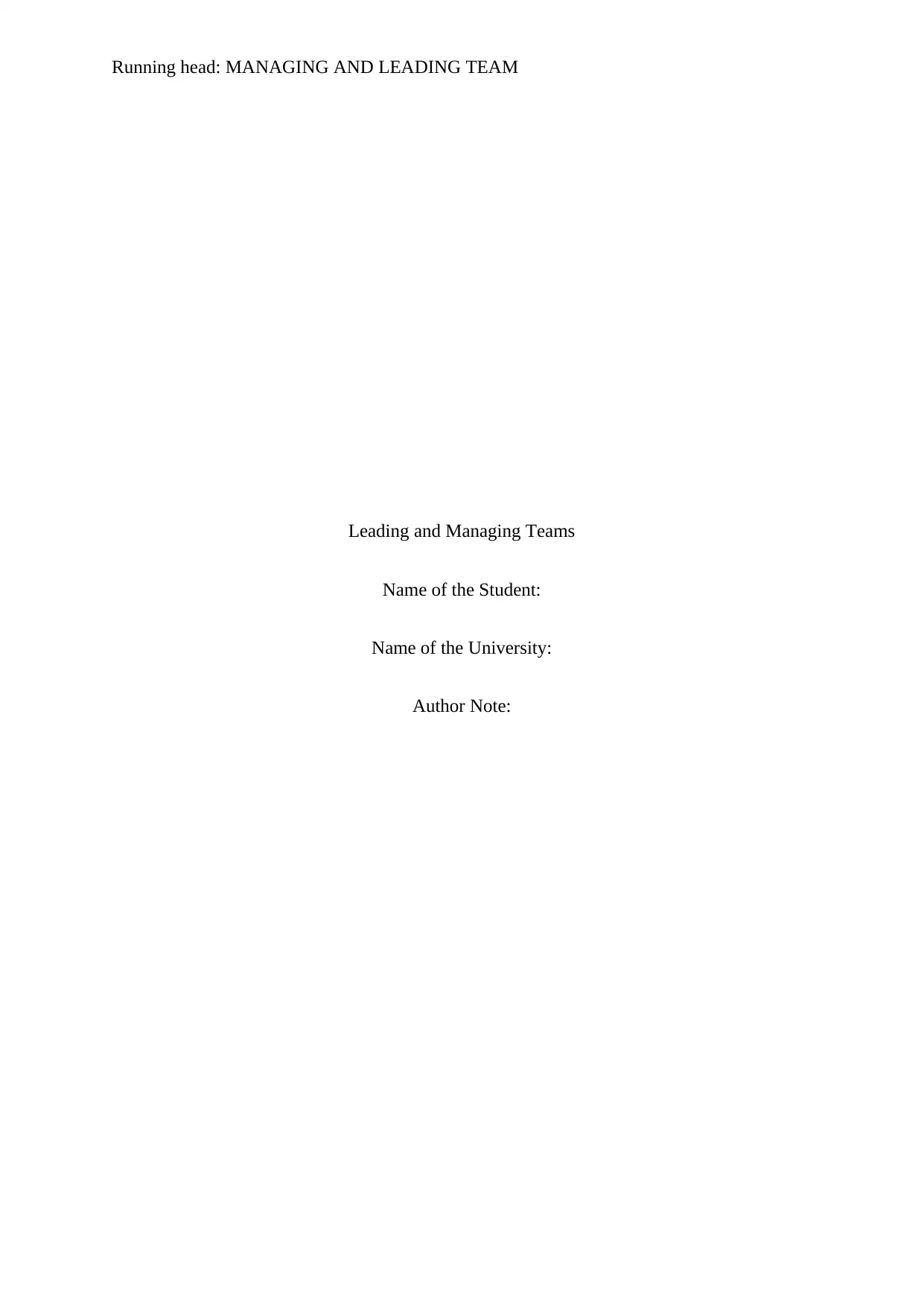
Running head: MANAGING AND LEADING TEAM
Leading and Managing Teams
Name of the Student:
Name of the University:
Author Note:
Leading and Managing Teams
Name of the Student:
Name of the University:
Author Note:
Paraphrase This Document
Need a fresh take? Get an instant paraphrase of this document with our AI Paraphraser
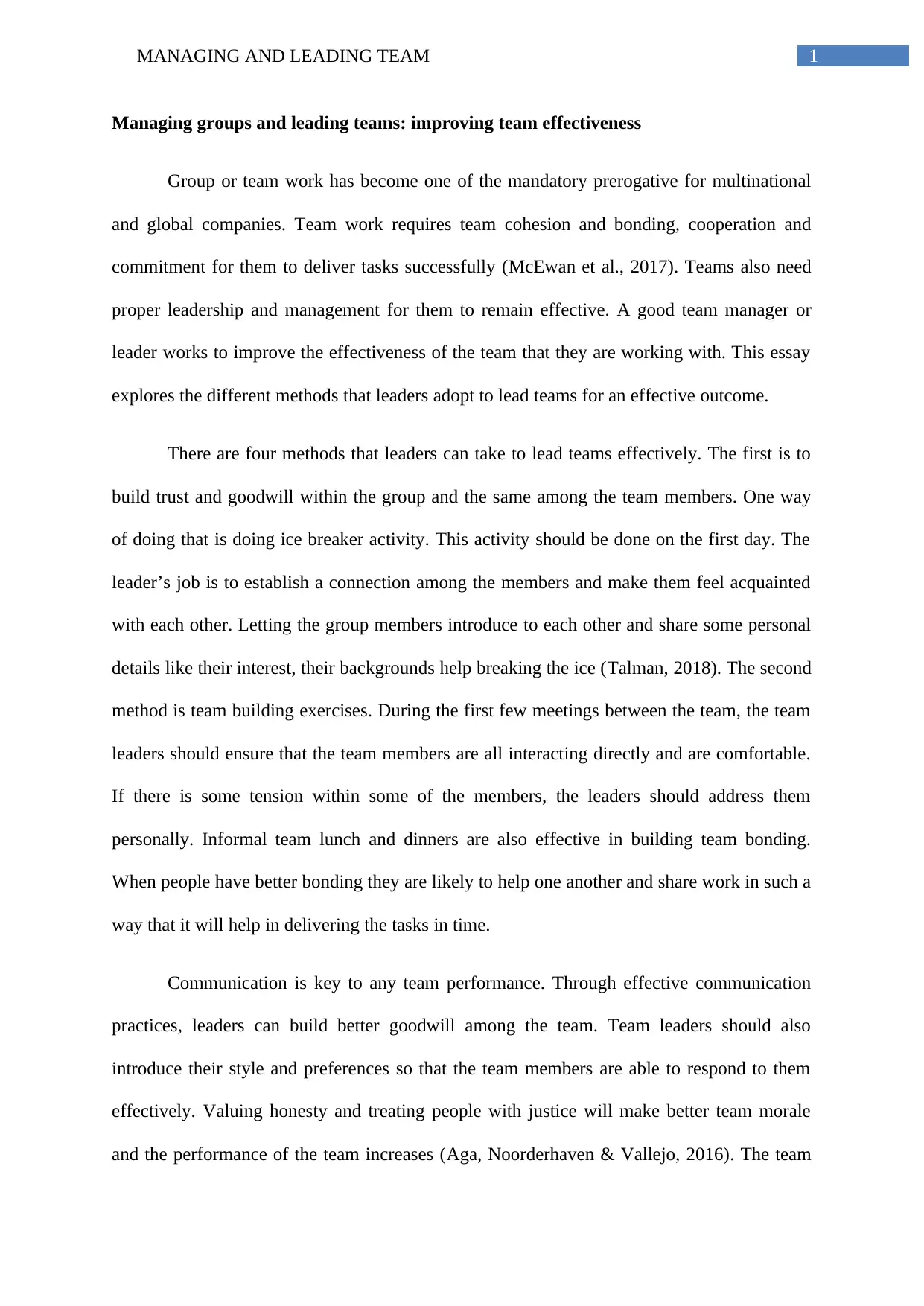
1MANAGING AND LEADING TEAM
Managing groups and leading teams: improving team effectiveness
Group or team work has become one of the mandatory prerogative for multinational
and global companies. Team work requires team cohesion and bonding, cooperation and
commitment for them to deliver tasks successfully (McEwan et al., 2017). Teams also need
proper leadership and management for them to remain effective. A good team manager or
leader works to improve the effectiveness of the team that they are working with. This essay
explores the different methods that leaders adopt to lead teams for an effective outcome.
There are four methods that leaders can take to lead teams effectively. The first is to
build trust and goodwill within the group and the same among the team members. One way
of doing that is doing ice breaker activity. This activity should be done on the first day. The
leader’s job is to establish a connection among the members and make them feel acquainted
with each other. Letting the group members introduce to each other and share some personal
details like their interest, their backgrounds help breaking the ice (Talman, 2018). The second
method is team building exercises. During the first few meetings between the team, the team
leaders should ensure that the team members are all interacting directly and are comfortable.
If there is some tension within some of the members, the leaders should address them
personally. Informal team lunch and dinners are also effective in building team bonding.
When people have better bonding they are likely to help one another and share work in such a
way that it will help in delivering the tasks in time.
Communication is key to any team performance. Through effective communication
practices, leaders can build better goodwill among the team. Team leaders should also
introduce their style and preferences so that the team members are able to respond to them
effectively. Valuing honesty and treating people with justice will make better team morale
and the performance of the team increases (Aga, Noorderhaven & Vallejo, 2016). The team
Managing groups and leading teams: improving team effectiveness
Group or team work has become one of the mandatory prerogative for multinational
and global companies. Team work requires team cohesion and bonding, cooperation and
commitment for them to deliver tasks successfully (McEwan et al., 2017). Teams also need
proper leadership and management for them to remain effective. A good team manager or
leader works to improve the effectiveness of the team that they are working with. This essay
explores the different methods that leaders adopt to lead teams for an effective outcome.
There are four methods that leaders can take to lead teams effectively. The first is to
build trust and goodwill within the group and the same among the team members. One way
of doing that is doing ice breaker activity. This activity should be done on the first day. The
leader’s job is to establish a connection among the members and make them feel acquainted
with each other. Letting the group members introduce to each other and share some personal
details like their interest, their backgrounds help breaking the ice (Talman, 2018). The second
method is team building exercises. During the first few meetings between the team, the team
leaders should ensure that the team members are all interacting directly and are comfortable.
If there is some tension within some of the members, the leaders should address them
personally. Informal team lunch and dinners are also effective in building team bonding.
When people have better bonding they are likely to help one another and share work in such a
way that it will help in delivering the tasks in time.
Communication is key to any team performance. Through effective communication
practices, leaders can build better goodwill among the team. Team leaders should also
introduce their style and preferences so that the team members are able to respond to them
effectively. Valuing honesty and treating people with justice will make better team morale
and the performance of the team increases (Aga, Noorderhaven & Vallejo, 2016). The team
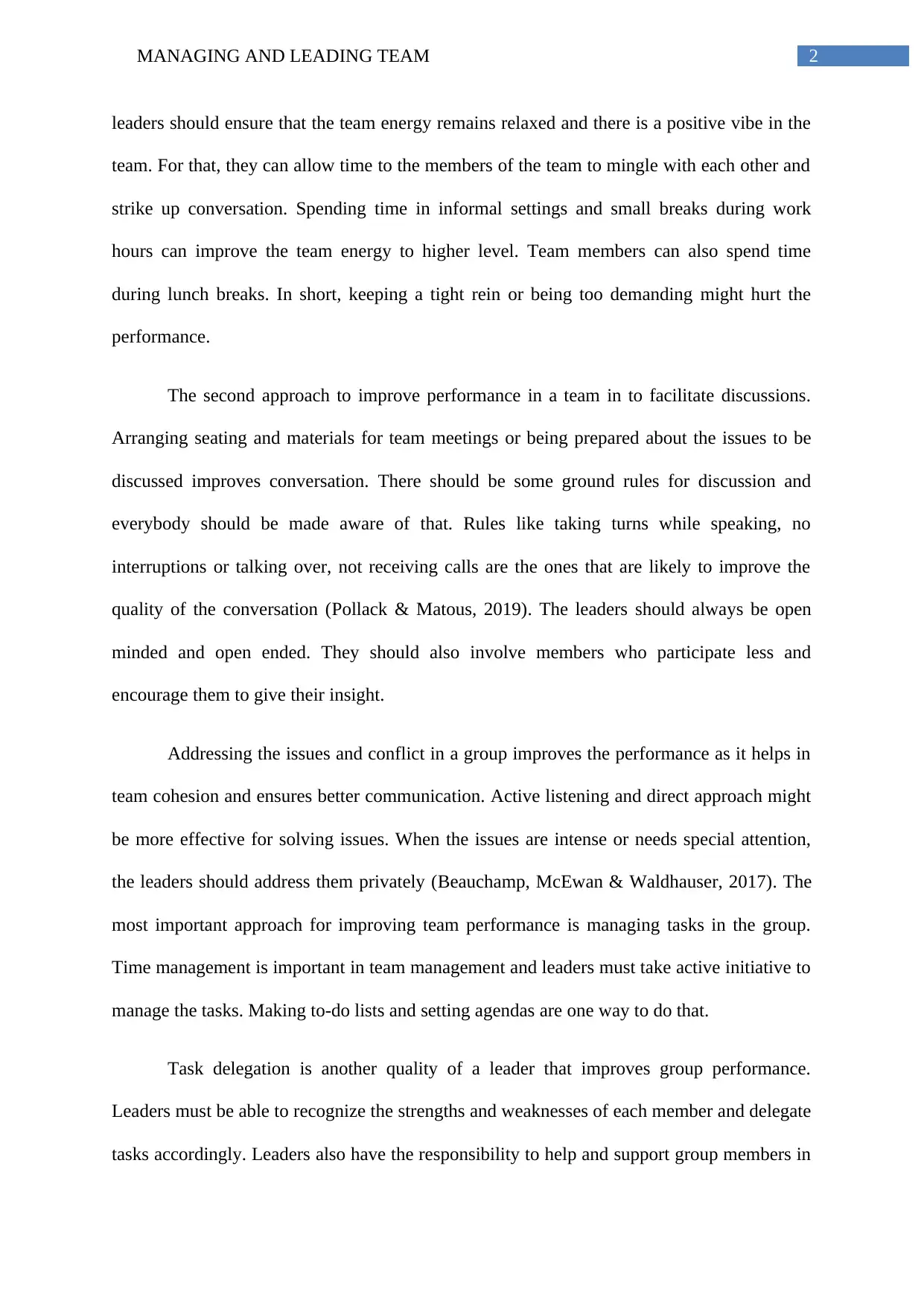
2MANAGING AND LEADING TEAM
leaders should ensure that the team energy remains relaxed and there is a positive vibe in the
team. For that, they can allow time to the members of the team to mingle with each other and
strike up conversation. Spending time in informal settings and small breaks during work
hours can improve the team energy to higher level. Team members can also spend time
during lunch breaks. In short, keeping a tight rein or being too demanding might hurt the
performance.
The second approach to improve performance in a team in to facilitate discussions.
Arranging seating and materials for team meetings or being prepared about the issues to be
discussed improves conversation. There should be some ground rules for discussion and
everybody should be made aware of that. Rules like taking turns while speaking, no
interruptions or talking over, not receiving calls are the ones that are likely to improve the
quality of the conversation (Pollack & Matous, 2019). The leaders should always be open
minded and open ended. They should also involve members who participate less and
encourage them to give their insight.
Addressing the issues and conflict in a group improves the performance as it helps in
team cohesion and ensures better communication. Active listening and direct approach might
be more effective for solving issues. When the issues are intense or needs special attention,
the leaders should address them privately (Beauchamp, McEwan & Waldhauser, 2017). The
most important approach for improving team performance is managing tasks in the group.
Time management is important in team management and leaders must take active initiative to
manage the tasks. Making to-do lists and setting agendas are one way to do that.
Task delegation is another quality of a leader that improves group performance.
Leaders must be able to recognize the strengths and weaknesses of each member and delegate
tasks accordingly. Leaders also have the responsibility to help and support group members in
leaders should ensure that the team energy remains relaxed and there is a positive vibe in the
team. For that, they can allow time to the members of the team to mingle with each other and
strike up conversation. Spending time in informal settings and small breaks during work
hours can improve the team energy to higher level. Team members can also spend time
during lunch breaks. In short, keeping a tight rein or being too demanding might hurt the
performance.
The second approach to improve performance in a team in to facilitate discussions.
Arranging seating and materials for team meetings or being prepared about the issues to be
discussed improves conversation. There should be some ground rules for discussion and
everybody should be made aware of that. Rules like taking turns while speaking, no
interruptions or talking over, not receiving calls are the ones that are likely to improve the
quality of the conversation (Pollack & Matous, 2019). The leaders should always be open
minded and open ended. They should also involve members who participate less and
encourage them to give their insight.
Addressing the issues and conflict in a group improves the performance as it helps in
team cohesion and ensures better communication. Active listening and direct approach might
be more effective for solving issues. When the issues are intense or needs special attention,
the leaders should address them privately (Beauchamp, McEwan & Waldhauser, 2017). The
most important approach for improving team performance is managing tasks in the group.
Time management is important in team management and leaders must take active initiative to
manage the tasks. Making to-do lists and setting agendas are one way to do that.
Task delegation is another quality of a leader that improves group performance.
Leaders must be able to recognize the strengths and weaknesses of each member and delegate
tasks accordingly. Leaders also have the responsibility to help and support group members in
⊘ This is a preview!⊘
Do you want full access?
Subscribe today to unlock all pages.

Trusted by 1+ million students worldwide
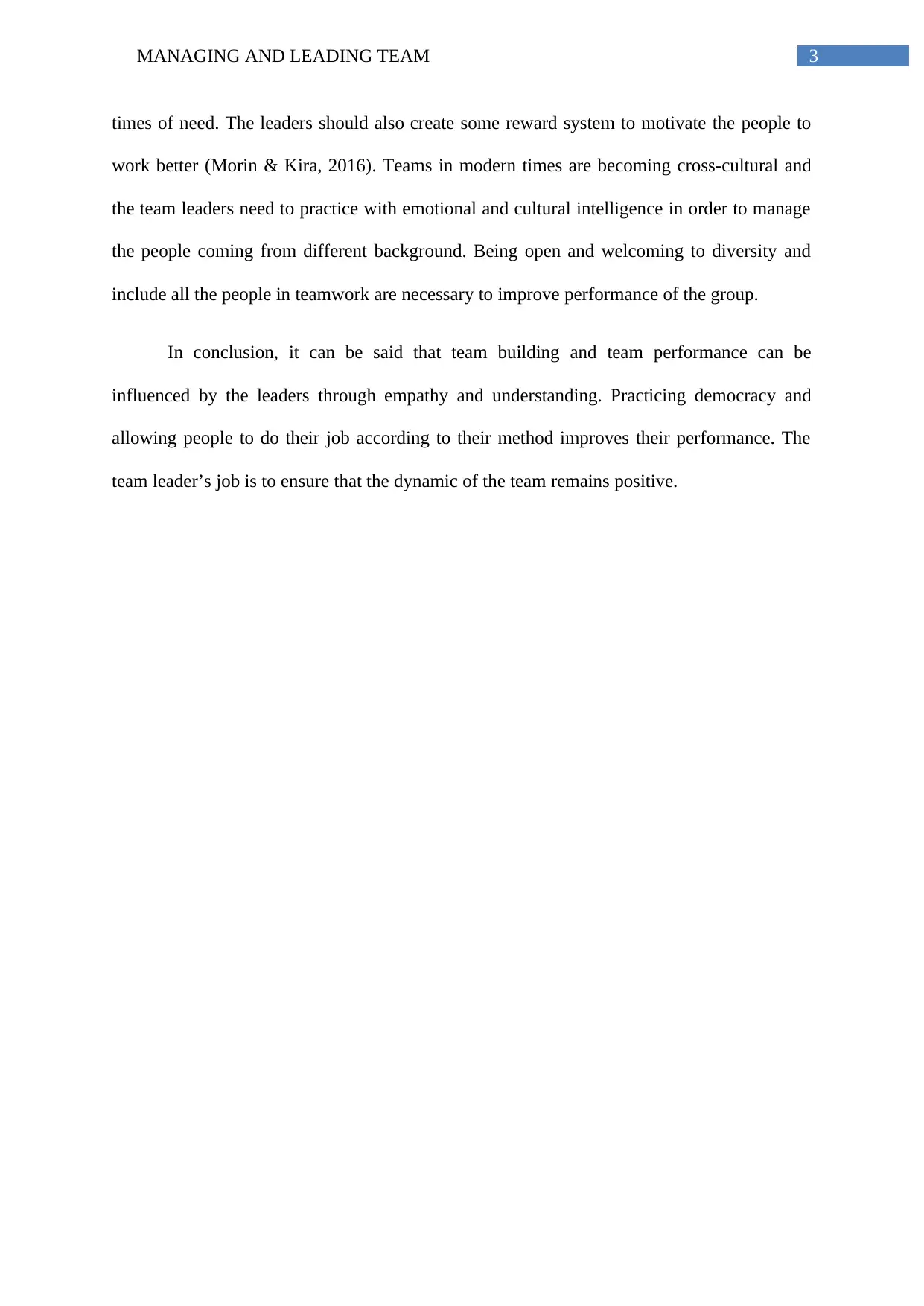
3MANAGING AND LEADING TEAM
times of need. The leaders should also create some reward system to motivate the people to
work better (Morin & Kira, 2016). Teams in modern times are becoming cross-cultural and
the team leaders need to practice with emotional and cultural intelligence in order to manage
the people coming from different background. Being open and welcoming to diversity and
include all the people in teamwork are necessary to improve performance of the group.
In conclusion, it can be said that team building and team performance can be
influenced by the leaders through empathy and understanding. Practicing democracy and
allowing people to do their job according to their method improves their performance. The
team leader’s job is to ensure that the dynamic of the team remains positive.
times of need. The leaders should also create some reward system to motivate the people to
work better (Morin & Kira, 2016). Teams in modern times are becoming cross-cultural and
the team leaders need to practice with emotional and cultural intelligence in order to manage
the people coming from different background. Being open and welcoming to diversity and
include all the people in teamwork are necessary to improve performance of the group.
In conclusion, it can be said that team building and team performance can be
influenced by the leaders through empathy and understanding. Practicing democracy and
allowing people to do their job according to their method improves their performance. The
team leader’s job is to ensure that the dynamic of the team remains positive.
Paraphrase This Document
Need a fresh take? Get an instant paraphrase of this document with our AI Paraphraser
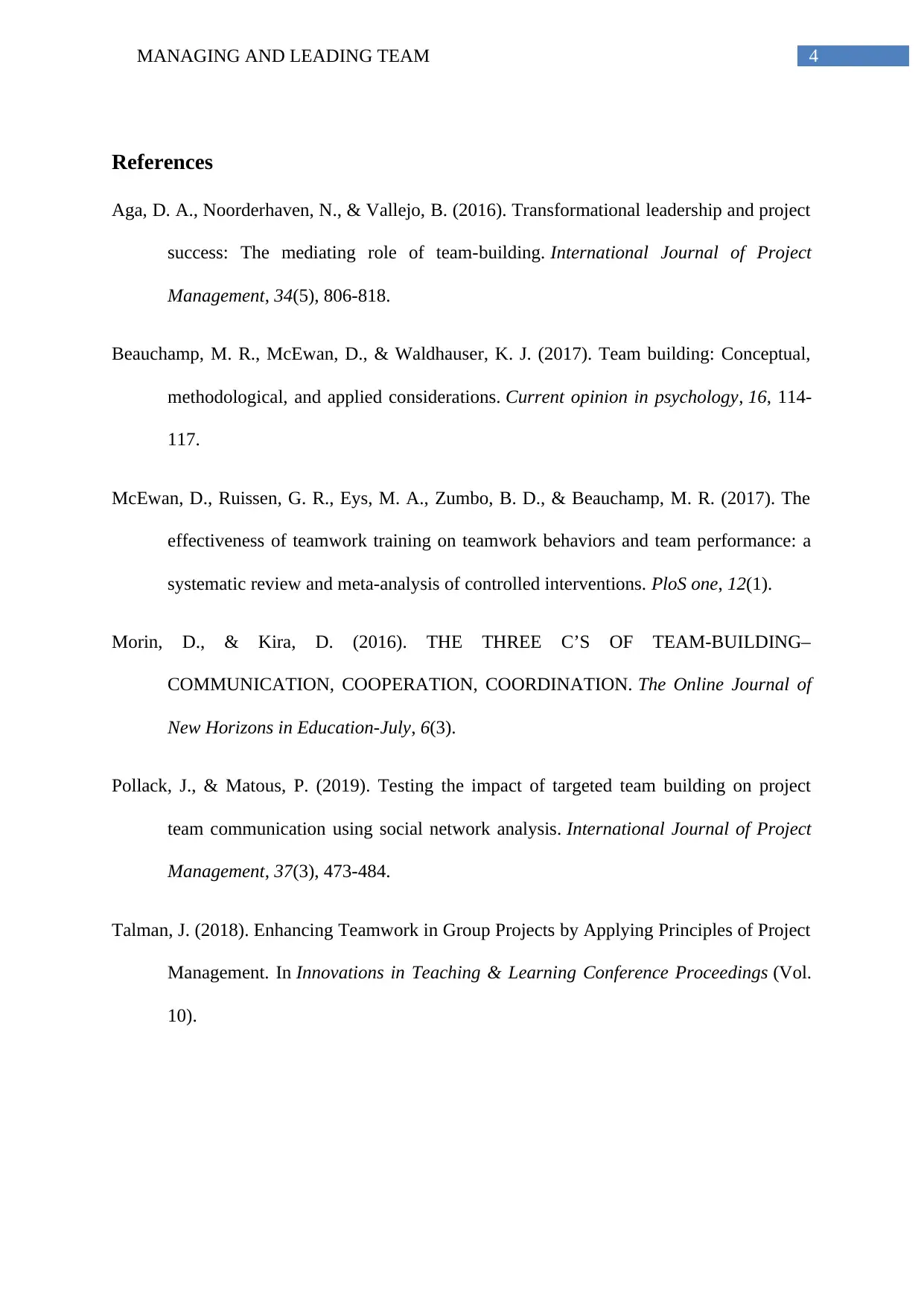
4MANAGING AND LEADING TEAM
References
Aga, D. A., Noorderhaven, N., & Vallejo, B. (2016). Transformational leadership and project
success: The mediating role of team-building. International Journal of Project
Management, 34(5), 806-818.
Beauchamp, M. R., McEwan, D., & Waldhauser, K. J. (2017). Team building: Conceptual,
methodological, and applied considerations. Current opinion in psychology, 16, 114-
117.
McEwan, D., Ruissen, G. R., Eys, M. A., Zumbo, B. D., & Beauchamp, M. R. (2017). The
effectiveness of teamwork training on teamwork behaviors and team performance: a
systematic review and meta-analysis of controlled interventions. PloS one, 12(1).
Morin, D., & Kira, D. (2016). THE THREE C’S OF TEAM-BUILDING–
COMMUNICATION, COOPERATION, COORDINATION. The Online Journal of
New Horizons in Education-July, 6(3).
Pollack, J., & Matous, P. (2019). Testing the impact of targeted team building on project
team communication using social network analysis. International Journal of Project
Management, 37(3), 473-484.
Talman, J. (2018). Enhancing Teamwork in Group Projects by Applying Principles of Project
Management. In Innovations in Teaching & Learning Conference Proceedings (Vol.
10).
References
Aga, D. A., Noorderhaven, N., & Vallejo, B. (2016). Transformational leadership and project
success: The mediating role of team-building. International Journal of Project
Management, 34(5), 806-818.
Beauchamp, M. R., McEwan, D., & Waldhauser, K. J. (2017). Team building: Conceptual,
methodological, and applied considerations. Current opinion in psychology, 16, 114-
117.
McEwan, D., Ruissen, G. R., Eys, M. A., Zumbo, B. D., & Beauchamp, M. R. (2017). The
effectiveness of teamwork training on teamwork behaviors and team performance: a
systematic review and meta-analysis of controlled interventions. PloS one, 12(1).
Morin, D., & Kira, D. (2016). THE THREE C’S OF TEAM-BUILDING–
COMMUNICATION, COOPERATION, COORDINATION. The Online Journal of
New Horizons in Education-July, 6(3).
Pollack, J., & Matous, P. (2019). Testing the impact of targeted team building on project
team communication using social network analysis. International Journal of Project
Management, 37(3), 473-484.
Talman, J. (2018). Enhancing Teamwork in Group Projects by Applying Principles of Project
Management. In Innovations in Teaching & Learning Conference Proceedings (Vol.
10).
1 out of 5
Related Documents
Your All-in-One AI-Powered Toolkit for Academic Success.
+13062052269
info@desklib.com
Available 24*7 on WhatsApp / Email
![[object Object]](/_next/static/media/star-bottom.7253800d.svg)
Unlock your academic potential
Copyright © 2020–2025 A2Z Services. All Rights Reserved. Developed and managed by ZUCOL.





